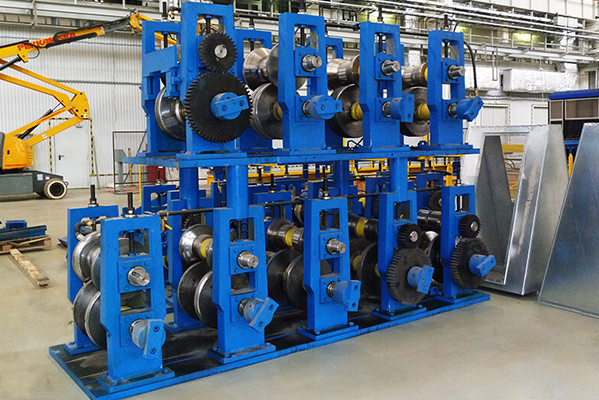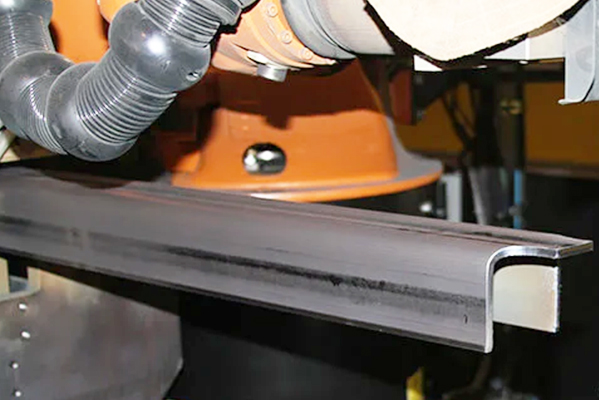Navigation Menu
Contact Us
- Email:
- info@wxavatar.com
- Address:
- Yurong Village, Yuqi Street, Huishan District, Wuxi, China.
Release Date:Jun 04, 2025 Visit:46 Source:Roll Forming Machine Factory
Introduction to Roll Forming in Railroad Manufacturing
Roll forming has become an essential process in the production of railroad components equipment, offering manufacturers a reliable method for creating durable, precise parts. This continuous bending operation transforms metal coils into consistent cross-sectional profiles needed for various rail applications. The technique's efficiency and precision make it particularly valuable for producing long lengths of railroad components with uniform quality.

As rail networks expand and modernize globally, the demand for high-quality railroad components equipment continues to grow. Roll forming meets this demand by providing cost-effective solutions that maintain strict dimensional tolerances while accommodating the heavy-duty requirements of rail infrastructure.
Key Railroad Components Produced Through Roll Forming
Manufacturers utilize roll forming technology to create several critical elements of railroad components equipment:
Rail tracks and guide rails: While the main rails are typically produced through hot rolling, many guide rails and special track sections are roll formed to precise specifications
Tie plates and fastening systems: These essential components that connect rails to railroad ties are efficiently mass-produced through roll forming
Signaling equipment housings: Protective enclosures for railway signaling systems often come from roll formed sections
Structural supports: Various braces, brackets, and support structures in rail stations and along tracks frequently originate from roll forming lines
Cable management systems: Channels and trays that organize and protect wiring along rail routes are commonly roll formed products
The process allows for the creation of these components with consistent quality while minimizing material waste—an important consideration in large-scale rail projects.
Advantages of Roll Forming for Railroad Applications
Roll forming offers several benefits that make it particularly suitable for manufacturing railroad components equipment:
Precision and Consistency: The incremental bending process ensures uniform dimensions along the entire length of components, critical for rail safety and performance. Tight tolerances can be maintained even over extended production runs.
Material Efficiency: Roll forming optimizes material usage, reducing waste compared to alternative manufacturing methods. This efficiency contributes to cost-effectiveness in large-volume rail projects.
Production Speed: Modern roll forming lines operate at high speeds, enabling manufacturers to meet the substantial quantities required for rail infrastructure projects without compromising quality.
Design Flexibility: The process accommodates a wide range of metal thicknesses and can produce complex cross-sections needed for specialized rail components. This flexibility allows engineers to design parts that meet specific performance requirements.
Strength Characteristics: The work hardening that occurs during the roll forming process can enhance the mechanical properties of certain rail components, contributing to their durability under heavy loads.
Technological Advancements in Roll Forming for Rail Components
Recent developments in roll forming technology have further enhanced its application in railroad components equipment manufacturing:
Computer-controlled systems now allow for real-time monitoring and adjustment of forming parameters, ensuring consistent quality
Advanced tooling materials extend the life of forming rolls, particularly important when working with high-strength steels used in rail applications
In-line punching and notching capabilities enable complete component fabrication in a single pass through the production line
Laser welding integration permits the creation of closed sections and complex assemblies directly in the forming process
Automated quality inspection systems verify dimensional accuracy and detect defects without slowing production
These innovations help manufacturers produce railroad components that meet increasingly stringent industry standards while maintaining competitive production costs.
Quality Considerations in Roll Formed Railroad Components
Given the safety-critical nature of railroad components equipment, quality control in roll forming processes receives particular attention:
Material selection: Manufacturers carefully choose metals with appropriate strength, fatigue resistance, and corrosion properties for rail applications
Process validation: Each production run undergoes rigorous testing to verify mechanical properties and dimensional compliance
Surface finish control: Proper surface characteristics are maintained to ensure component performance and longevity
Traceability systems: Batch tracking allows for complete documentation of materials and production parameters
Performance testing: Components are subjected to simulated service conditions to verify their suitability for rail applications
These measures help ensure that roll formed railroad components meet the exacting standards required for safe, reliable rail operations.
Economic Impact of Roll Forming on Railroad Manufacturing
The adoption of roll forming technology has significantly influenced the economics of railroad components equipment production:
Reduced per-unit costs through high-volume efficiency
Lower energy requirements compared to some alternative forming methods
Minimized material waste contributes to overall project cost management
Reduced secondary operations shorten production timelines
Consistent quality decreases rejection rates and associated costs
These economic benefits make roll forming an attractive option for rail component manufacturers facing competitive pressures while needing to maintain high quality standards.
Future Outlook for Roll Forming in Rail Component Production
As rail networks continue to evolve, roll forming technology is expected to play an expanding role in railroad components equipment manufacturing. Emerging trends include:
Development of more sophisticated profiles to meet new rail design requirements
Increased integration with other manufacturing processes for complete component solutions
Adaptation to new materials being introduced in rail infrastructure
Further automation to enhance productivity and consistency
Implementation of data analytics for predictive maintenance and process optimization
These advancements will likely solidify roll forming's position as a preferred manufacturing method for many types of railroad components in the coming years.

Conclusion
Roll forming has established itself as a vital process in modern railroad components equipment manufacturing, offering an optimal balance of precision, efficiency, and cost-effectiveness. Its ability to produce high-quality, durable components at scale makes it particularly valuable for the rail industry's needs. As technology advances and rail systems become more sophisticated, roll forming will continue to adapt, maintaining its important role in building and maintaining rail infrastructure worldwide. Manufacturers investing in advanced roll forming capabilities position themselves to meet current and future demands for reliable railroad components.